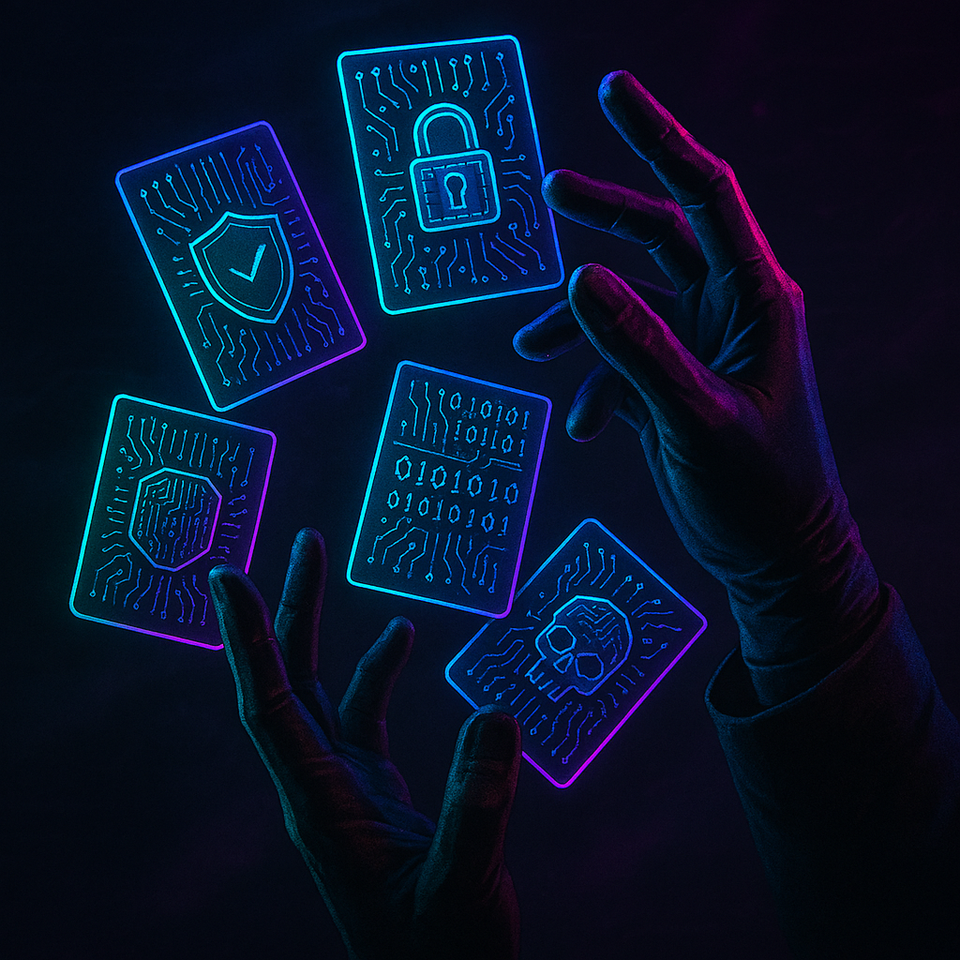Lifting the Veil, Bargain Basement Access, Clarity Before a Crisis, Routers' Wrong Turns, Unsafe Hands, and Follow the Path. It's CISO Intelligence for Friday, 3rd October 2025.
Taking a peek behind the curtain, low-cost big hits, the sentinel approach, a little flaw goes a long way, the helpful con, and safety always comes first.

Table of Contents
- Turning to the Dark Side: A Peek Into Dark Web Monitoring
- RAM it Like You Stole It: The $50 Hack that Bypasses Intel and AMD Security
- Unmasking Your Virtual Flesh: Navigating Attack Surface Visibility Software
- The Art of Phish: Hackers Transform Milesight Routers into Spam Mills
- Your Service Desk is the New Attack Vector—Here's How to Defend It
- GSA Policies: The Government's Tsar of TPRM
Turning to the Dark Side: A Peek Into Dark Web Monitoring
Dark web monitoring: because ignorance isn’t bliss when it comes to breaches.
What You Need to Know
Board members and executive management need to realize the critical importance of dark web monitoring as a proactive measure in cyber defense strategy. Cyber threats don't just surface on the clear web; the dark web hosts a labyrinth of hidden criminal activities that directly threaten corporate security. You're expected to endorse budget allocation to enhance monitoring solutions and ensure your security teams are armed with the necessary tools to mitigate these threats efficiently.
CISO focus: Dark Web Intelligence
Sentiment: Strong Positive
Time to Impact: Immediate
The dark web—a shadowy frontier of the internet—is often misunderstood and shrouded in myth. While it offers anonymity for benign purposes, it's infamous for its role in facilitating illicit activities. For businesses, monitoring the dark web is an essential part of a robust cybersecurity posture. But why does dark web monitoring matter to your enterprise, and how can it shield your business from looming cyber threats?
A Web of Secrecy and Danger
The dark web constitutes a small portion of the broader deep web, which is not indexed by standard search engines. Within this encrypted network, search engines like Tor offer users anonymity, enabling both innocuous and nefarious activities. Unfortunately, the latter often dominates headlines, as cybercriminal enterprises leverage this anonymity to trade stolen data, sell malware, and even offer hacking services.
Publishing businesses and financial institutions are frequent targets, as these dark corners are ripe with opportunities to profit from stolen personal data, intellectual property, and financial credentials.
Why Proactive Monitoring is Crucial
Dark web monitoring is analogous to an early warning system for potential cyberattacks. By keeping tabs on this covert ecosystem, companies can work preemptively to protect their data. When breached data surfaces on the dark web, rapid identification and response can prevent further exploitation and severe reputational damage.
How Does Dark Web Monitoring Work?
Monitoring tools use advanced algorithms and AI-powered scans to sift through forums, marketplaces, and hidden communities in the dark web to detect whether sensitive company information has been leaked. These tools notify security teams when they find threats or leaked data, enabling organizations to take swift corrective actions, such as informing affected personnel, resetting passwords, or collaborating with law enforcement where necessary.
Game-Changing Benefits
- Early Threat Detection: Identifies breaches before they lead to severe data loss or reputational harm.
- Enhanced Incident Response: Speeds up reaction times with real-time alerts, helping contain threats rapidly.
- Legal Compliance: Some industries mandate dark web monitoring for compliance with data protection regulations.
- Financial Safeguarding: Potentially saves millions by avoiding the costs associated with data breaches, including fines and brand damage.
Tactical Implementation Tips
- Identify Assets and Prioritize: Not all data is equal. Prioritize monitoring critical assets.
- Maintain Regular Checks: The dark web is a dynamic environment; consistent monitoring helps keep centric insights fresh.
- Integrate with Overall Security Strategy: Dark web monitoring should complement broader security measures, like network monitoring and intrusion detection systems.
Staying Ahead of Cybercriminals
For businesses operating in an ever-interconnected digital world, understanding the value of dark web monitoring can significantly augment cybersecurity strategies. By leveraging comprehensive monitoring solutions, organizations can stay one step ahead of attackers, safeguarding both digital and financial brand foundations.
Vendor Diligence Questions
- What technologies does the vendor use to ensure the complete and accurate monitoring of dark web activity related to our assets?
- How frequently is the organization notified of potential threats or breaches discovered on the dark web?
- Can the vendor provide references or case studies that showcase the impact of their dark web monitoring solutions?
Action Plan
-
Assess Current Dark Web Monitoring Capabilities:
- Conduct a gap analysis to evaluate existing capabilities and identify areas for improvement.
-
Budget and Resources Allocation:
- Secure funding to invest in comprehensive dark web monitoring tools and training for security teams.
-
Develop Incident Response Enhancements:
- Revise the incident response plan to integrate dark web monitoring findings, ensuring rapid and efficient threat mitigation.
-
Educate and Train Personnel:
- Launch awareness sessions to educate teams on the risks associated with the dark web and the role of monitoring in preventing threats.
-
Regular Review and Update:
- Schedule bi-annual reviews of dark web findings to adapt security strategies based on emerging threats and trends.
Source: What Is Dark Web Monitoring? | UpGuard
https://www.upguard.com/blog/dark-web-monitoring
RAM it Like You Stole It: The $50 Hack that Bypasses Intel and AMD Security
What's cheaper than a cup of coffee and can hijack your CPUs? This RAM-cle scheme.
What You Need to Know
A freshly discovered attack dubbed 'Battering RAM' exposes vulnerabilities in the security architecture of Intel and AMD cloud infrastructures. By exploiting a $50 hardware hack, attackers can manipulate memory addresses to access and alter encrypted data without detection. It's crucial for executives to assess potential impacts on cloud services and fortify defenses. Immediate actions include auditing cloud vendor security measures and applying any available patches.
CISO Focus: Hardware Exploits in Cloud Security
Sentiment: Strong Negative
Time to Impact: Immediate
In a shocking revelation, researchers unveiled an attack aptly named 'Battering RAM' that capitalizes on a low-cost hardware hack to undermine Intel and AMD cloud security measures. This bargain-basement interloper, priced at just $50, steers its way through complex virtual enclaves and encrypted data, leaving IT teams scrambling to defend their electronic fortresses.
Attack Mechanism
At the core of Battering RAM lies a DDR4 interposer packed with analog switches, artfully camouflaged as a benign surveillance device during initial checks. Once nestled in the memory pathway, a simple tactical flip activates the interposer, redirecting legitimate addresses to malevolent ones. This clandestine redirection allows for the corruption and manipulation of sensitive memory segments without any red flags.
- Intel Platforms: The attack can read and overwrite encrypted data within victim environments.
- AMD Platforms: It bypasses protections added to counter the 'BadRAM' exploits documented last year, slipping malicious sequences into virtual machines undetected.
Why It Works
The Achilles' heel of the Intel and AMD encryption frameworks lies in their omission of cryptographic freshness checks. This design flaw prioritizes larger memory allocations, inadvertently opening a backdoor for runtime exploits like Battering RAM to wield memory aliases undeterred. In simpler terms, the guardrails meant to protect data crumble under the weight of cleverly disguised interference.
Implications for Cloud Security
Battering RAM's relatively rudimentary setup yet profound impact signals a paradigm shift in perceived cloud security. While corporations are lulled into a false sense of security by highly sophisticated built-in defenses, these cost-effective exploits remind us that threat actors don’t always play by the same set of fiscal rules.
This development marks a significant setback for companies heavily reliant on cloud infrastructure, where security breaches could translate into severe operational and financial losses. The very foundation of trusted computing environments in cloud services stands vulnerable, heralding a need for immediate and reactive measures to safeguard sensitive data circuits.
Immediate Steps for Mitigation
- Conduct a thorough risk assessment on current cloud infrastructure.
- Push for speedy deployment of potential firmware updates and patches by Intel and AMD.
- Strengthen vendor contracts to ensure robust encryption measures and real-time intrusion detection capabilities.
Lessons Revealed
This exploit brings to light a haunting reality: security designs might be inherently flawed if they prioritize memory capacity over continued cryptographic checks. The cloud's Achilles' heel is evidently not in overt complex software vulnerabilities but in the hardware layer where such vulnerabilities can pivot unnoticed.
In light of these revelations, cybersecurity teams must adopt a more holistic approach to cloud defense strategies—one that does not discount the layers below the visible surface.
A Fresh Perspective on Cloud Security
As businesses rally to patch and protect against such invasive exploits, one thing becomes increasingly clear: when it comes to security, cost should never be equated with capability. Awareness and vigilance remain the watchwords in this ever-expanding digital war front.
With the cybersecurity landscape rarely standing still, this latest attack prompts a shift towards integrating physical security measures alongside traditional software defenses—protection should be as foundational as the infrastructure upon which it is built.
Vendor Diligence
- What specific hardware security measures are in place to detect interposer-based attacks?
- How frequently are firmware updates and patches applied to mitigate newly discovered exploits?
- What encryption methodologies are used and have they been recently tested against hardware-based hacks?
Action Plan
- Immediate Memory Audits: Work with cloud service vendors to verify the integrity of existing memory; inspect for unauthorized hardware.
- Awareness Campaign: Train staff on recognizing suspicious hardware modifications in server rooms.
- Secure Vendor Communication: Ensure open lines of dialogue with vendors to stay updated on protection measures and rapid responses to vulnerabilities.
Source: The Hacker News - $50 Battering RAM Attack Breaks Intel and AMD Cloud Security Protections
Unmasking Your Virtual Flesh: Navigating Attack Surface Visibility Software
In the digital realm, knowing where your mess is just as important as cleaning it up.
What You Need to Know
As cyber threats evolve, understanding your organization's virtual vulnerabilities becomes paramount. Attack surface visibility software offers a comprehensive lens through which to view potential entry points for cyber threats, safeguarding assets by prioritizing vulnerabilities. Executives are expected to incorporate these insights into strategic planning and budget allocations, ensuring they invest in robust defensive technologies while continuously monitoring and adapting to the dynamic cyber landscape.
CISO Focus: Cyber Threat Management
Sentiment: Positive
Time to Impact: Immediate to Short (3-18 months)
In today’s hyper-connected digital ecosystem, your company’s attack surface — all potential vulnerabilities and entry points a cyber attacker could exploit — is as sprawling as it is complex. Recognizing this challenge, many organizations are turning to attack surface visibility software to gain a clearer picture of their cyber landscape. This technology gives you the essential visibility to manage and prioritize your vulnerabilities before they become problematic.
Why Attack Surface Visibility Matters
Attack surface visibility software is critical in identifying and mitigating vulnerabilities across your IT environment, from shadow IT to exposed servers and insecure cloud assets. By highlighting where attacks are most likely, this software enables companies to take a proactive stance, rather than reacting to security breaches after they occur.
-
Comprehensive Asset Discovery: Identifying all digital assets, even the forgotten ones, is a monumental task. Attack surface visibility tools automate this process, ensuring full coverage.
-
Vulnerability Prioritization: Not all risks are equal. These tools help distinguish between benign states and those that are urgent and need immediate attention.
-
Continuous Monitoring: The cyber landscape is dynamic. Continuous assessment of your attack surface ensures you stay ahead of evolving threats.
Key Features to Consider
When selecting attack surface visibility software, several features can distinguish between an effective system and a subpar tool.
-
Integration Capabilities: Ensure the software seamlessly interfaces with existing tools and systems, aiding in cohesive security operations.
-
Real-Time Alerts: Immediate notifications are crucial for addressing vulnerabilities as they emerge, minimizing potential damage.
-
User Interface: A user-friendly interface increases efficiency by making data actionable quickly and intuitively.
-
Scalability: As businesses grow, so does their attack surface. The software must scale with your organization’s size and complexity.
Making the Right Choice
Selecting an appropriate tool involves more than just ticking boxes on a features list. Consider your organization’s specific needs and cyber maturity. Engage stakeholders from multiple departments, including IT, security, and even HR, to ensure the software aligns with company-wide objectives.
Possible Challenges
While attack surface visibility software offers significant advantages, it’s not without challenges.
-
Implementation Hurdles: Integrating new software into a sprawling IT ecosystem can be fraught with technical challenges and resistance from team members accustomed to previous setups.
-
Overwhelming Data: The sheer volume of vulnerability data can paralyze decision-making if not managed properly. Choosing software with solid analytics capabilities to parse through and prioritize this data is essential.
-
Budget Constraints: Advanced software can be expensive. Balancing cost with the depth and breadth of protection offered is a critical consideration.
Iron Shield – Or Screen Door?
At the end of the digital day, having a clear view of your attack surface transforms how your organization perceives and handles cyber threats. With effective attack surface visibility, your business isn't just putting up defenses; it's orchestrating a symphony of preemptive strategies to outmaneuver even the most sophisticated cyber adversaries.
Vendor Diligence
Questions
- Does the software integrate smoothly with our current IT infrastructure and cybersecurity tools?
- Can the vendor provide case studies or testimonials demonstrating the software's effectiveness in similar industries?
- How does the vendor ensure continuous software updates to address emerging threats?
Action Plan
- Conduct a needs assessment to determine specific requirements for attack surface visibility software.
- Engage IT and security teams to evaluate potential vendors and tools.
- Define clear metrics for the success of the software's implementation, including reduction in detected vulnerabilities and improved response times.
- Schedule regular training to ensure all relevant stakeholders are adept at utilizing the software.
- Perform annual reviews to assess the software's efficacy and make necessary adjustments.
Source: Choosing the Right Attack Surface Visibility Software | UpGuard
The Art of Phish: Hackers Transform Milesight Routers into Spam Mills
Hackers turned your routers into spammy DJs—spinning the same phishing track until someone bumps to their rhythm.
What You Need to Know
A newly discovered cybersecurity threat has emerged as hackers exploit vulnerabilities in Milesight routers to send phishing SMSs to unsuspecting European users. These routers, primarily used for business communications across Europe, have become the latest tool in the cybercriminal arsenal. Immediate actions are required to secure these devices and prevent further breaches. The executive management board is expected to collaborate closely with IT teams to deploy necessary patches and communicate risks to stakeholders.
CISO Focus: Internet of Things (IoT) Security
Sentiment: Strong Negative
Time to Impact: Immediate
Security experts have discovered a large-scale security breach involving Milesight routers, which hackers have leveraged to circulate phishing SMSs aimed at European users. These attacks exploit known vulnerabilities in the routers' firmware, emphasizing the immediate need for a patch to tighten defenses.
Impact Analysis
The affected routers have primarily facilitated business communication across Europe, amplifying the impact of this security breach. Since these devices serve as pivotal points in corporate communication networks, the compromise could potentially lead to massive data leaks and financial losses.
Technical Exploit
The hackers have exploited Milesight routers using a sophisticated method, embedding malicious scripts into the routers’ firmware. Once infected, these routers automatically dispatch phishing messages that appear genuine, increasing the likelihood of unsuspecting recipients engaging with the malicious content.
Scope of the Threat
- Device Exploitation: Thousands of routers widely deployed in business settings have been compromised.
- Geographical Focus: Primarily targeting European users, likely due to the prevalence of Milesight routers in this region.
- Phishing Risks: Enhanced risk of data breaches as users are tricked into sharing personal and financial details.
Response and Mitigation
The silver lining is that Milesight has acknowledged the vulnerability and hurriedly released a firmware update aimed at neutralizing the threat. However, the onus is now on users and businesses to ensure this patch is deployed swiftly across all devices.
Just When You Thought It Was Safe to Browse
The prophetic tale of cyber insecurity spotlights the ever-evolving landscape of threats poised against connected devices. This recent breach is a stern reminder of the constant vigilance required to protect an increasingly digital world. Ensure systems are fortified, vigilance is unwavering, and you’re one step ahead. Because the hackers are already one beat behind, waiting for you to tap your cyber feet.
Vendor Diligence
- How does the vendor manage firmware upgrades for their devices?
- What encryption practices does the vendor employ for data in transit across their routers?
- Can the vendor provide a history of any previously identified vulnerabilities and their responses?
Action Plan
- Firmware Update: Deploy the latest firmware update provided by Milesight to all routers immediately.
- Network Monitoring: Implement enhanced network traffic monitoring to identify unusual patterns or unauthorized access.
- Stakeholder Communication: Brief all stakeholders about the threat and steps being taken to mitigate the risks.
- ISOLATION: Temporarily isolate affected routers from network communications to prevent further phishing attacks.
- Incident Report: Compile a comprehensive report on the incident for future learnings and legal compliance.
Source: Hackers Exploit Milesight Routers to Send Phishing SMS to European Users
Your Service Desk is the New Attack Vector—Here's How to Defend It
"Because who knew the Help Desk was actually a Launchpad for cyber hijinks?"
What You Need to Know
Recent insights from BleepingComputer highlight the emerging threat of cyber attacks targeting service desks. These departments, traditionally focused on user support, have now become weak links in cybersecurity defenses. As corporate leaders, it's imperative to strengthen service desk security protocols and provide comprehensive training to better handle cyber threats. It's expected you consider immediate augmentation of security measures around service desks as a primary action item in upcoming board discussions.
CISO Focus: Security Awareness and Training
Sentiment: Strong Negative
Time to Impact: Immediate
In an era where remote work and digital interactions have become ubiquitous, the service desk—long considered an operation support hub—has evolved into a prime target for cyber attacks. To the uninitiated, this might seem counterintuitive. However, cyber adversaries have increasingly recognized these IT support vectors as a lucrative avenue for breaching organization defenses.
Why Service Desks?
-
Access Points Galore: Service desks provide a centralized spot where numerous inquiries and requests are processed. This also means they manage a variety of access requests, making them a trove for anyone looking to find a backdoor into an organization's network.
-
Human Element: At the heart of any attack is the ability to exploit the 'human factor'. Service desk employees, without proper training and continuous updates on security protocols, can inadvertently grant access to malicious actors posing as legitimate users.
-
Trust Network: These desks maintain an inherent level of trust and rapport with the organization's employees, an aspect which attackers cunningly exploit through sophisticated social engineering tactics.
Unveiling the Attack Strategy
Attackers are leveraging advanced phishing schemes and social engineering strategies, often masquerading as end-users requiring urgent assistance. Through manipulated narratives, attackers have succeeded in extracting sensitive information or gaining unauthorized access.
Protecting the Fortress: Defensive Strategies
Organizations can take several steps to fortify their service desk defenses:
-
Comprehensive Training Programs:
- Regular and mandatory cybersecurity awareness training for all service desk personnel is essential.
- Training modules should include identifying phishing attacks, recognizing social engineering tactics, and following verification protocols for suspicious requests.
-
Multi-factor Authentication (MFA):
- Implementing MFA for all service desk operations creates an additional security layer, ensuring that access requests are verified through more than just passwords.
-
Enhanced Monitoring and Anomaly Detection:
- Vigilant monitoring of activities associated with service desk operations helps in early detection of irregularities that may suggest an ongoing cyber threat.
-
Robust Verification Protocols:
- Establishing stringent verification processes before executing any account-related changes or sensitive actions can deter potential attacks.
-
Encourage Reporting Culture:
- Cultivating an environment where employees feel comfortable reporting suspicious activities, even if they prove to be false alarms, is critical.
The Long Game: Continuous Adaptation
Cyber threats are dynamic; the methods attackers use evolve as do their targets. Ensuring long-term protection demands continuous evaluation and adaptation of strategies, technologies, and training programs. This proactive stance is the difference between staying one step ahead or falling victim to potentially devastating breaches.
Vendor Diligence Questions
- What protocols do vendors have in place to protect service desk operations from potential cyber threats?
- How do vendors ensure that their personnel are trained and updated with the latest cybersecurity best practices?
- Can vendors provide metrics or case studies that demonstrate the effectiveness of their cybersecurity strategies on service desks?
Action Plan
- Evaluate Current Protocols: Conduct an immediate review of existing service desk security measures and identify potential vulnerabilities.
- Implement Training Programs: Initiate a comprehensive cybersecurity training program tailored for service desk employees, focusing on the most current threat vectors.
- Adopt MFA and Security Technologies: Prioritize the implementation of multi-factor authentication and enhanced monitoring solutions pertinent to service desk operations.
- Enhance Verification Measures: Strengthen identity verification procedures to confirm user authenticity before executing sensitive requests.
- Foster Open Communication: Establish an organizational culture that promotes the reporting and discussion of suspicious activities without repercussions.
Source: Your Service Desk is the New Attack Vector—Here's How to Defend It.
GSA Policies: The Government's Tsar of TPRM
When Uncle Sam plays cyber chess, you better know which piece is under attack.
What You Need to Know
Federal agencies and government contractors are mandated to adhere to stringent guidelines for third-party risk management (TPRM) as outlined by the General Services Administration (GSA). This policy sets the stage for ensuring ironclad security in safeguarding sensitive data, requiring a panoramic view of the risks supplied by third-party vendors. For executives and board members, the call to action is understanding these standards, ensuring compliance, and actively managing vendor risks.
CISO Focus: Third-Party Risk Management
Sentiment: Strong Positive
Time to Impact: Immediate
In an era where cyber threats know no bounds and data breaches can unhinge governments, the General Services Administration’s (GSA) directive on third-party risk management (TPRM) acts as a guiding light for government contractors. The focus here is on preemptive security measures, vendor compliance, and risk mitigation strategies.
GSA: Setting The Bar
The GSA’s policy encompasses an all-encompassing approach, ensuring data security and compliance with federal norms. This initiative requires government contractors to not only implement robust cybersecurity measures but also equips them with the tactical know-how for proactive management of potential risks posed by third-party vendors.
Key Aspects of GSA’s Third-Party Risk Management
-
Risk Assessment Protocols:
- Continuous monitoring of vendors.
- Comprehensive auditing processes.
- Evaluation criteria for onboarding new vendors.
-
Compliance Guidelines:
- Strict adherence to NIST standards and FISMA guidelines.
- Safeguarding against unauthorized data access.
- Regular updating and management of compliance documentation.
-
Vendor Management Strategies:
- Structured vetting processes to ensure vendor reliability.
- Clear demarcations of compliance responsibilities.
- Proven track record of regulatory adherence.
The Current TPRM Landscape
The cyber realm is perpetually buzzing with threats, and an oversight in vendor management can propel government contractors into a whirlpool of regulatory penalties and reputational damage. The GSA’s policy serves to rectify this by aligning contractors' cybersecurity frameworks with government benchmarks, making them formidable in defense readiness.
How Contractors Can Adapt
Contractors must beef up their vendor management protocols ensuring they meet GSA guidelines. Building a fortified cybersecurity environment requires:
- Implementing real-time monitoring and risk assessment tools.
- Training personnel on emerging threats and compliance tactics.
- Engaging in regular security audits and updating policies.
Perfecting the Art of Vendor Scrutiny
Maximizing vendor management involves adopting stringent due diligence processes. It translates into developing a comprehensive understanding of every vendor’s cybersecurity posture, mitigating third-party risk through transparency and continuous evaluation.
Uncle Sam’s Battle Plan: Delving into the Digital Frontlines
Ensuring a robust tier of cybersecurity via third-party assessment is not merely about compliance; it's a strategic move to bolster national security. By taking a vigilant approach, government contractors are better positioned to withstand the rigors of the digital battlefield.
Vendor Diligence
- How do you ensure compliance with GSA’s third-party risk management guidelines?
- What measures have you implemented for continuous monitoring of potential risks?
- Describe your process for regular auditing and updating of cybersecurity protocols.
Action Plan
- CISO Teams to Conduct Risk Assessment Reviews: Initiate comprehensive vendor risk assessments to identify vulnerabilities and potential regulatory compliance issues.
- Implement Vendor Compliance Training Programs: Establish regular training and updates for teams about the latest GSA compliance requirements and cyber threat intelligence.
- Facilitate Continuous Monitoring and Reporting: Adopt real-time monitoring solutions to stay ahead of potential security breaches or threats linked to third-party vendors.
Source: TPRM for Government Contractors: General Services Administration Policies | UpGuard
CISO Intelligence is lovingly curated from open source intelligence newsfeeds and is aimed at helping cybersecurity professionals be better, no matter what their stage in their career.
We’re a small startup, and your subscription and recommendation to others is really important to us.
Thank you so much for your support!
CISO Intelligence by Jonathan Care is licensed under Creative Commons Attribution-NonCommercial-NoDerivatives 4.0 International




